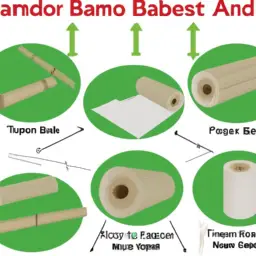Hey there! Ready to make a sustainable change in your bathroom routine? Look no further than bamboo toilet paper!
In this step-by-step guide, I’ll show you how to make the switch and reduce your environmental impact. We’ll explore the benefits of bamboo toilet paper, how to choose the right one for you, and even how to properly dispose and recycle it.
Get ready to go green with bamboo TP!
The Environmental Impact of Traditional Toilet Paper

I rarely consider the environmental impact of using traditional toilet paper. Like most people, I’ve always just grabbed whatever was convenient and never thought twice about it. However, lately I’ve been reading more about the devastating effects of deforestation, and it got me thinking.
According to research, the production of traditional toilet paper contributes to deforestation on a massive scale. Every year, millions of trees are cut down to make toilet paper, leading to the destruction of natural habitats and loss of biodiversity.
Thankfully, there are alternatives to traditional toilet paper that can help reduce deforestation. One popular option is bamboo toilet paper. Bamboo is a fast-growing plant that requires less water and land compared to trees. It can be harvested sustainably without causing significant harm to the environment. By using bamboo toilet paper, we can help conserve forests and protect wildlife habitats.
Another alternative to consider is recycled toilet paper. This type of toilet paper is made from post-consumer waste paper, such as newspapers and office paper. By using recycled toilet paper, we can reduce the demand for virgin wood pulp, which in turn helps to reduce deforestation.
Why Bamboo Toilet Paper Is a Sustainable Choice

Bamboo toilet paper is not only an eco-friendly option, but it is also a sustainable choice due to its fast growth rate and minimal environmental impact. As more people become aware of the benefits of bamboo toilet paper, its popularity has been steadily growing. Let’s take a closer look at why bamboo toilet paper is a sustainable and responsible choice for your bathroom needs.
One of the main advantages of bamboo toilet paper is its fast growth rate. Bamboo is one of the fastest-growing plants in the world, with some species growing up to 39 inches in just 24 hours. This means that bamboo can be harvested and replenished at a much quicker rate compared to traditional trees used for toilet paper production. By using bamboo toilet paper, we can reduce deforestation and protect our forests.
Furthermore, bamboo has a minimal environmental impact. It requires significantly less water, pesticides, and fertilizers compared to other crops. Bamboo also has natural antibacterial properties, making it an excellent choice for toilet paper, as it reduces the need for harsh chemicals during the manufacturing process.
To summarize the benefits of bamboo toilet paper:
| Benefits | |
|---|---|
| Fast growth rate | |
| Minimal environmental impact | |
| Reduced deforestation | |
| Less water, pesticides, and fertilizers | |
| Natural antibacterial properties |
How to Choose the Right Bamboo TP for Your Needs

When searching for the perfect bamboo toilet paper, it’s important to consider your individual needs and preferences. Choosing eco-friendly options is a great way to reduce your environmental impact, and bamboo toilet paper is an excellent choice in this regard. However, with so many brands available, it can be overwhelming to make a decision. Comparing different bamboo TP brands can help you find the one that meets your specific requirements.
Firstly, consider the thickness and ply of the toilet paper. Some people prefer a thicker and softer feel, while others prioritize durability and strength. Take note of the number of plies and the overall thickness to ensure it meets your desired comfort level.
Next, look at the packaging of the bamboo toilet paper. Opt for brands that use minimal or recycled packaging to further reduce waste. Additionally, check if the brand has any certifications, such as FSC or Rainforest Alliance, which guarantee sustainable sourcing and production practices.
Lastly, consider the price and quantity. While bamboo toilet paper may be a bit pricier than traditional options, it’s important to find a brand that fits within your budget. Look for bulk options or subscribe to save money in the long run.
Step-by-Step Guide to Switching to Bamboo TP

To begin the transition to bamboo toilet paper, gather the necessary supplies and familiarize yourself with the steps involved. Making the switch is a simple and straightforward process that can have a positive impact on the environment. Here is a step-by-step guide to help you make the switch:
| Steps | Benefits of Bamboo |
|---|---|
| 1. Research different brands of bamboo toilet paper and choose one that suits your needs. | Bamboo is a sustainable resource that grows quickly and requires minimal water and pesticides. Using bamboo toilet paper helps reduce deforestation and minimizes the environmental impact of traditional toilet paper production. |
| 2. Purchase your preferred brand of bamboo toilet paper. Look for options that are whitened with hydrogen peroxide, a natural and eco-friendly alternative to chlorine bleach. | Bamboo toilet paper is soft and gentle on the skin, making it a comfortable option for personal use. It is also biodegradable and septic-safe, ensuring it won’t harm the environment or clog your plumbing. |
| 3. Replace your current toilet paper with bamboo toilet paper. Make sure to dispose of the old toilet paper responsibly, either by recycling or composting. | By switching to bamboo toilet paper, you are contributing to a more sustainable future. Bamboo is a renewable resource that regrows quickly, making it an excellent alternative to traditional toilet paper made from trees. |
Tips for Proper Disposal and Recycling of Bamboo TP

Proper disposal and recycling of bamboo TP is essential for sustainability and minimizing waste. When it comes to disposing of bamboo toilet paper, it’s important to remember that it can’t be flushed down the toilet like regular toilet paper. Bamboo TP is biodegradable, but it takes time for it to break down in water. Flushing it can lead to clogs in the plumbing system and cause environmental issues. Instead, the proper way to dispose of bamboo TP is to throw it in the trash bin. Make sure to wrap it in a biodegradable bag or paper before tossing it to minimize its impact on landfills.
Recycling options for bamboo TP can vary depending on your local recycling facilities. Some recycling centers may accept bamboo toilet paper, while others may not. It’s best to check with your local recycling center or waste management department to find out if they accept bamboo TP. If they do, make sure to separate it from other waste and place it in the designated recycling bin.
If recycling options aren’t available in your area, consider composting bamboo TP instead. It can be a great way to reduce waste and enrich your garden soil. Just make sure to follow the proper guidelines for composting to ensure its effectiveness.
The Future of Sustainable Toilet Paper: Bamboo Innovations

But, I believe the future of sustainable toilet paper lies in bamboo innovations.
Bamboo toilet paper offers several advantages over traditional options. One of the key benefits is the manufacturing process. Bamboo grows much faster than trees, making it a highly renewable resource. It can be harvested and regrown within three to five years, while trees take decades to reach maturity. This rapid growth rate makes bamboo a more sustainable choice for toilet paper production.
Additionally, bamboo toilet paper is more environmentally friendly. It requires less water and fewer pesticides to grow compared to traditional wood pulp. Bamboo also has natural antimicrobial properties, reducing the need for harsh chemicals during the manufacturing process. This makes it a healthier option for both the environment and our skin.
Furthermore, bamboo toilet paper is softer and stronger than traditional options. It provides a luxurious feel while maintaining durability. This means that less paper is needed per use, reducing waste and the frequency of replacement.
Conclusion
Switching to bamboo toilet paper is a simple and effective way to reduce our environmental impact. Its sustainable production and biodegradable nature make it a smart choice for anyone looking to go green.
By following the step-by-step guide and properly disposing and recycling bamboo TP, we can contribute to a more sustainable future.
Let’s make the switch and make a positive impact on the planet.


